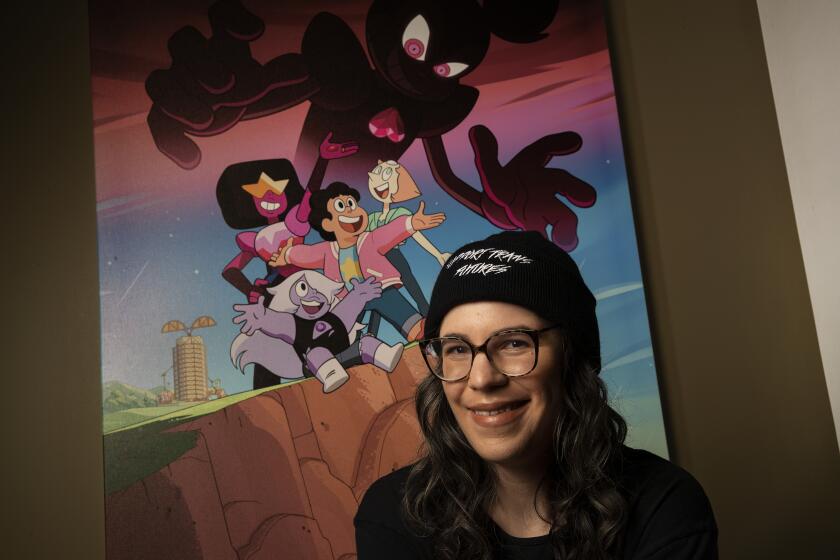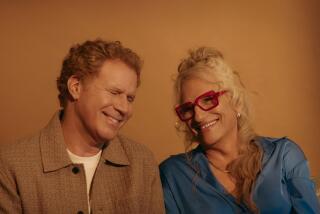Commentary: ‘She-Ra’ rewrote the script for TV’s queer love stories. Here’s why it matters
- Share via
This story contains spoilers from the fifth and final season of “She-Ra and the Princesses of Power.”
In “She-Ra and the Princesses of Power,” many of the most powerful warriors in the war over the fate of the universe are magical princesses. They are strong and they are brave, and you believe they’re going to win in the end.
One of the things that has been abundantly clear since “She-Ra’s” 2018 debut is that the animated DreamWorks/Netflix series, developed for television by executive producer Noelle Stevenson, is set in a world that is completely, casually LGBTQ-inclusive.
On Etheria, princesses are just as likely to be married to each other as they are to have boyfriends. Not even the most ruthless villain around has trouble remembering anybody’s pronouns. It’s a planet where gender isn’t constricted, heteronormativity does not exist, and queer people just get to be.
And still, the conclusion of “She-Ra‘s” fifth and final season surprised me with the actualization of its central queer love story.
“She-Ra and the Princesses of Power” showrunner Noelle Stevenson talks Season 5 and that thing that happened in the series finale.
The series has always revolved around Adora and Catra — former friends who landed on opposite sides of a war after the former discovered her magical destiny and learned she was raised by the forces of evil. Adora switched sides and Catra was hurt — which led her to chose her own destructive path.
In Season 5 they finally reconcile, partly in response to the emergence of an even bigger threat. As they reestablish their closeness over subsequent episodes, it’s easy to root for them to sort out their relationship.
But I didn’t expect to see them admit their love for each other, share a kiss and join the main action of the climactic final battle to save the universe. And yet it happened. I was thrilled. I rewatched the episode immediately.
To be clear: My surprise does not mean their moment was unearned. It was easy to pick up on the implications of the ambiguity of their relationship, because for so long queer subtext — whatever its intent — was the stand-in for actual representation. It definitely seemed romantic feelings could be a part of Catra and Adora’s dynamic, and plenty of viewers had picked up on it since the beginning.
I was surprised because I didn’t expect to be able to see a story like theirs unfold on a kids’ cartoon — at least not yet.
A story in which the central heroine, a young woman with the weight of the world on her shoulders, gets the girl and saves the day. Not only that: Their love is why she’s able to save the day.
Nonbinary shapeshifter Double Trouble fits perfectly into the inclusive world of Netflix’s “She-Ra and the Princesses of Power.”
I’d become so used to being let down in the past that I’d unknowingly internalized some of the homophobic arguments that have been made for years about what is or isn’t “appropriate,” especially for kids.
It turns out I wasn’t the only one who expected some pushback.
“I kept it so close to my chest because I was so terrified of being told that we were never going to be allowed to do it,” Stevenson said in a recent interview about Adora and Catra’s relationship. “It [took] me a while before I finally put my cards on the table [and said], ‘This is what I’ve been building to this whole time and I want this to be the canonical textual arc of the final season.’”
In the final moments of the big battle to stop the villainous Horde Prime destroying their planet, things look dire for the remaining warriors of the Rebellion. They are on the cusp of losing everything.
Things look especially bad for Adora, who is ready to sacrifice herself to save her friends.
Luckily, Catra is committed to being with Adora no matter what happens. Her asking Adora out loud to stay because she loves her, and Adora saying she loves her back, is the catalyst that allows them to stop Horde Prime once and for all.
Throughout its run, “She-Ra” has not hesitated to depict how feelings can be scary because they can make you vulnerable. This moment between Catra and Adora shows that being honest with yourself and others about your feelings can also be powerful and heroic.
It’s significant that this message is conveyed through a queer love story because there are still so many forces in the real world that want you to believe that love is wrong.
This is a landmark time for queer visibility on TV, with increasingly meaningful LGBTQ representation happening even within children’s programming.
“Steven Universe” creator Rebecca Sugar explains why LGBTQ representation was central to the show — and looks back on how it made TV history.
Even before this unequivocal affirmation of Adora and Catra’s relationship, “She-Ra” had set a high bar for what inclusive storytelling looks like: Married princesses Netossa and Spinerella, committed members of the Rebellion, have been steady presences since the first season (and get some time in the spotlight in Season 5). Bow has two dads, loving parents who tell endearing dad jokes. And Season 4 introduced Double Trouble, whose moral complexities are due to their being a mercenary, not because they happen to be nonbinary.
But excitement about the progress being made in the entertainment industry with regard to queer representation is necessarily tempered by a reality in which violence against LGBTQ people — particularly trans women of color — is still happening. State legislatures and the current administration continue to push for limiting protections and to enact discriminatory policies. Strangers on the internet still think it’s funny to make homophobic memes.
It’s exhausting.
So this TV show that lets all kids, and specifically queer kids, see that being honest about their feelings can make them a hero is as exciting as it is important. Queer heroes deserve their happy endings too.
I had long settled for stories with ambiguous queer undertones. I’m glad that with shows like “She-Ra and the Princesses of Power,” kids growing up now don’t have to.
More to Read
The complete guide to home viewing
Get Screen Gab for everything about the TV shows and streaming movies everyone’s talking about.
You may occasionally receive promotional content from the Los Angeles Times.








